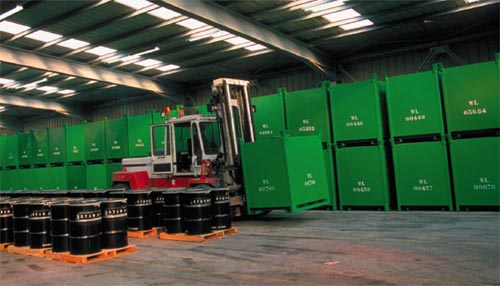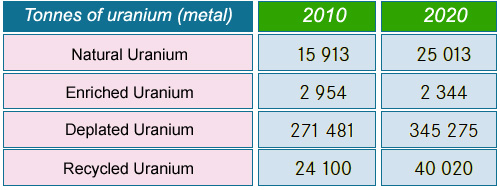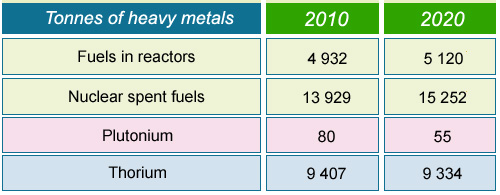Inventory of reusable uranium and plutonium stocks

Storage of depleted uranium
The counterpart of enriching uranium in isotope 235 to provide fuel for nuclear reactors is an accumulation of relatively large quantities of depleted uranium. There were 271,000 tonnes at the end of 2010, and were expected to be 345,000 tonnes by 2020. This uranium is stored, mainly at Pierrelatte on the Tricastin site as U3O8, but also at Bessines-sur-Gartempe (87). These stocks are significant but are minimal in comparison with other raw materials such as coal and oil. This material is not very radioactive at all.
© AREVA
The radioactive species present in the spent fuels unloaded from reactors include two with an energy content, which are considered to be recoverable materials. They are plutonium and uranium.
In France, the plutonium is extracted from spent fuels from reactors at the La Hague plant, during reprocessing. It is then partly recycled in MOX fuels and will ultimately go back into the reactor.
The uranium is also a recoverable material because it could provide an almost inexhaustible amount of energy if it were one day used in breeder reactors. The enrichment of natural uranium has produced very large stocks of depleted uranium (uranium low in isotope 235), which is the main substance in the inventory.

Inventory of (recoverable) uranium
In terms of tonnages, the main recoverable material is depleted uranium. Next, a long way behind, comes reprocessed uranium. The inventory also contains the enriched uranium in the process of being used in reactors, and the natural uranium entering the fuel manufacturing cycle.
© Source: ANDRA 2012 Inventory
The components of the uranium inventory are all very different: natural uranium from mines, uranium enriched with isotope 235 used in reactor fuels, depleted uranium, and uranium recovered during the reprocessing of spent fuels.
Depleted uranium: This is by far the biggest component of the inventory. It is the counterpart of enrichment with uranium-235, which occurs during the manufacture of nuclear fuel. It is produced in larger quantities than the other recoverable materials. To obtain a tonne of fuel enriched to 3.5%, you have to deplete 5.6 tonnes of uranium to 0.2%. Depleted uranium is one of the least radioactive materials that there is. It is even less radioactive than the uranium in mines because its accompanying radioactive descendants have been removed. Most of it is stored at Pierrelatte and Bessines-sur-Gartempe.
Recycled uranium: Recycled uranium, separated from spent fuel during reprocessing, is stored at Pierrelatte and Marcoule. It is more radioactive than natural uranium because of the presence of impurities. Some recycled uranium, which contains slightly more uranium-235 than natural uranium does, goes back into enrichment facilities. This re-enriched uranium, known as enriched reprocessed uranium ERU, is used to manufacture new fuel. It is recycled in a reactor.
Plutonium: Plutonium is also extracted when spent fuel is reprocessed. Because of its composition it is not suitable for use in weapons (nuclear bombs). It is stored mainly at La Hague and the CEA’s facilities. Most plutonium is not explicitly included in the inventory. The majority is used to manufacture MOX fuel. It then spends three or four years in a reactor core before being unloaded into a spent fuel pool. The quantity of spent MOX fuel stored in pools at the end of 2010 was 170 tonnes.

Inventory (continued): spent fuel, plutonium, thorium
Not all the spent fuel that comes out of reactors is reprocessed. Some of it is stored in pools, including spent MOX fuel assemblies (170 tonnes in 2010). The 40 tonnes of plutonium are the plutonium not used in the manufacture of MOX fuel. ANDRA also counts thorium, which could be used in future possible thorium reactors.
© Source: ANDRA 2012 Inventory
Spent fuel not yet been reprocessed
Not all the spent fuel unloaded from reactors is reprocessed. The fuels that are not reprocessed are stored in large pools for possible reprocessing in the future. These materials contain plutonium and uranium, which could be recovered if they were reprocessed. A distinction is made between:
– The spent fuels containing uranium oxide stored at La Hague;
– The enriched reprocessed uranium (ERU) fuels and MOX fuels which could be reprocessed after 2020;
– Other spent fuels linked to old reactor types such as SuperPhenix (200 tonnes), or to research or defence.
The materials used to manufacture weapons or held as strategic stocks are not included in the national inventory because they are covered by defence secrecy. France’s Defence Ministry holds an inventory of these sensitive materials. France has made a commitment to keep count of them for non-proliferation purposes.
Other articles on the subject « Waste Inventory »
France: waste panorama (1)
An overview of French waste categories… In France, radioactive waste is split into five cat[...]
France: waste panorama (2)
An overview of French waste categories (continued)… Low- and intermediate-level short-lived[...]
US panorama
The case of the greatest nuclear power Nuclear-powered US Navy vessels, past production of nuclea[...]
Various radioactive waste
Radioactive waste from many different sources… When radioactive waste is mentioned, people [...]
Mining residues
Waste from uranium extraction The residues from processing uranium ores are disposed of on the si[...]
Medicine and research
Radioactive sources, producers of waste outside the nuclear industry… Biology labora[...]
Military waste
A separate system Using the gaseous diffusion process, the AREVA Pierrelatte facility produced en[...]
Radium-bearing waste
Legacy waste – weakly radioactive but long-lived Recent and less recent industrial activities hav[...]
Waste from Dismantling
Dismantling of facilities: graphite waste Experience with dismantling nuclear power plants is onl[...]
Waste from Industry
Obsolete radioactive sources, the legacy of radium applications There are numerous industrial app[...]